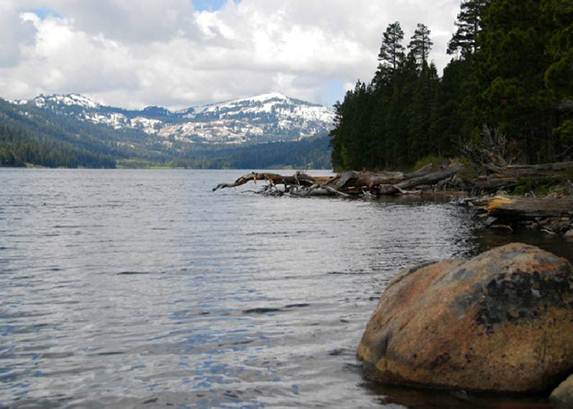

In the Sierra Nevada Mountains just north of Lake Tahoe, lush forests surrounding Independence Lake help naturally filter the water keeping it crystal clear. Independence Lake is an important watershed for California's water supply and a source of drinking water for western Nevada. © Mike Conner/TNC
Do you know where your water comes from? If not, you're not alone. A study from last year showed that 77 percent of Americans don't know where their water comes from. (That doesn't include people who use private wells.) Thankfully, modern engineering lets us turn on the tap and clean, clear water comes out. We don't often think about where our water comes from because we aren't forced to. But these sources -- rivers, lakes, reservoirs, and watersheds -- provide abundant drinking water for millions of Californians and we're placing more demand on them than ever.
It's time we pay more attention to the natural sources of water we depend on every day. In California, we rely on 157 million acres of land spanning eight states to collect and filter the water we drink -- from source to tap. The water in your sink could've originated from a glacier on Mount Shasta or in the Teton National Forest in Wyoming. California draws water from places far and wide. Another reason it's important to know the source is that the quality of fresh water in lakes, rivers, and streams is directly affected by how healthy the surrounding land is. Natural land -- like grasslands or forests -- plays a really important role filtering our water. In this video a third grader provides a great explanation of how nature keeps water clean.
Because the land in a watershed affects the water quality it's important that we have a good idea of the state of the land around our water sources. We created the first study that maps all of the watersheds -- 157 million acres total -- that supply drinking water to 80 percent of Californians. If you live in California you can visit our new website to look up the path your water takes from source to tap. We have more than 500 California cities and towns mapped so far and continue to add more. Mapping our watersheds also gives us a clear idea of what's protected and what's vulnerable. About 84 percent of California's drinking water sources are vulnerable. Sixteen percent of our watersheds are highly protected -- meaning they're either part of a national park or wilderness area. A little more than half (51 percent) is public land, which has some protection, but is also used for other things like logging, mining and energy production. The last third (33 percent) is in private hands so the level of protection varies and depends on the land owner, the land use, and the local laws.
There are a lot of threats to the health of our watersheds and quality of fresh water: inappropriate land management, urban growth, climate change and wildfires, for example. Preserving natural lands and restoring habitat can address these threats and help protect our drinking water supplies for current and future generations of Californians.
Environmental conservation can directly impact the quality of water in your home. Take San Francisco as an example. Some people know that San Francisco's water comes from the well-protected Hetch Hetchy watershed. But not as many people know that San Francisco also relies on watersheds in the Coast Range that feed the Calaveras and San Antonio Reservoirs, which aren't as well protected. We're working with the San Francisco Public Utilities Commission and other partners to help protect the natural habitats and rangelands that keep these watersheds healthy. One huge benefit is that better natural water quality, thanks to healthier watersheds, can translate into lower filtration and treatment costs.
Take a minute to find your water source today. If you live in California, you can find your drinking water source here. If you live in another big city you can view the global map and report. The global study identifies rivers and lakes that serve as water sources for 68 international and 398 U.S. cities and gives detailed information on watersheds for the 27 largest U.S. cities. Knowing which watersheds supply drinking water is a critical first step to making sure they're protected. As it gets hotter and more crowded in California (as in the rest of the world) people will be a lot more interested in where their water comes from. Keeping watersheds healthy by protecting natural habitat and being mindful about how we use and develop surrounding land will help make sure our fresh water stays clean for everyone.
